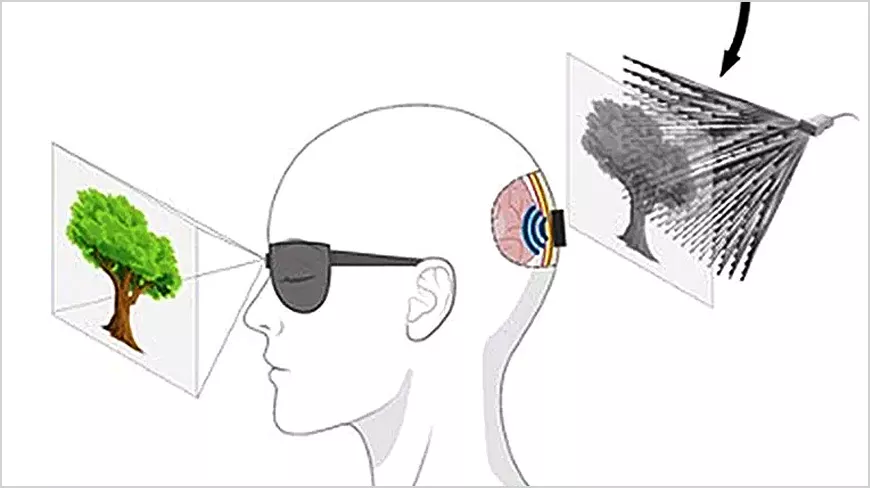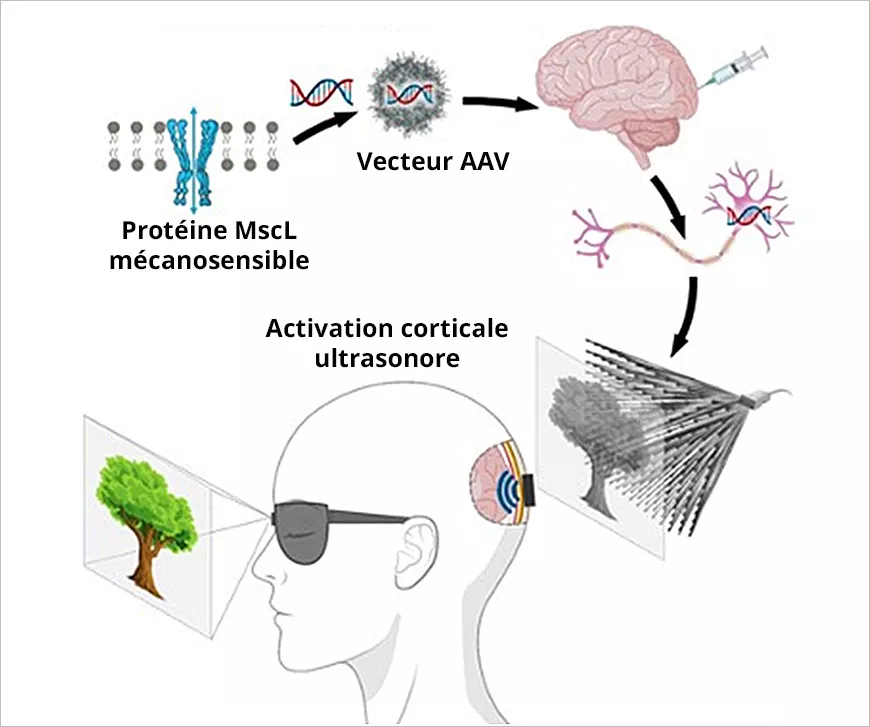Restoring vision with a new brain-machine interface: sonogenetic therapy
Restoring vision through a therapy combining genetics and ultrasound? That's the goal pursued by an international team led by Inserm research directors Mickael Tanter and Serge Picaud, respectively associated with the Institute of Physics for Medicine (ESPCI Paris/PSL University/Inserm/CNRS) and the Institute of Vision (Sorbonne University/Inserm/CNRS), in partnership with the Institute of Molecular and Clinical Ophthalmology in Basel.

In a new study, they have provided proof of concept of this so-called sonogenetic therapy in animals. This therapy involves genetically modifying certain neurons to be remotely activated by ultrasound. The results show that when used on rodent neurons, sonogenetics can induce a behavioral response associated with light perception. This discovery suggests the possibility of long-term application in blind individuals with optic nerve atrophy. The study is published in Nature Nanotechnology.
Sonogenetic therapy
Sonogenetic therapy involves genetically modifying certain neurons to be remotely activated by ultrasound. This technology had previously been tested in culture, and initial in vivo tests had not revealed its therapeutic potential due to its very high spatiotemporal resolution. The genetic modification involves introducing the genetic code of a "mechanosensitive ion channel" into the cells. Neurons expressing this channel can then be remotely activated by low-intensity ultrasound applied to the brain's surface without the need for contact. (See explanatory diagram).

Ultrasonic waves can penetrate deep tissues, such as the visual cortex, even from the surface of the dura mater surrounding the brain, and target very specific areas. These waves form the basis of technologies such as ultrasound or high-resolution brain imaging. In this case, they allow for very selective activation, as only neurons carrying the mechanosensitive channel and targeted by the ultrasound beam are stimulated.
In a recent study, a team of researchers led by Inserm research directors Mickael Tanter and Serge Picaud tested the efficacy of this sonogenetic therapy in animals. The goal of this research is to provide a solution to restore vision in patients who have lost the connection between their eyes and their brain due to pathologies such as glaucoma, diabetic retinopathy, or hereditary or nutritional optic neuropathies.
Their results indicate that sonogenetic stimulation of the visual cortex can induce a behavioral response associated with light perception. The animal learns an associative behavior in which it seeks to drink as soon as it perceives light. Ultrasound stimulation of its visual cortex induces the same reflex only if the neurons of the cortex express the mechanosensitive channel. The animal's behavior suggests that sonogenetic stimulation of its cortex induced light perception, leading to the behavioral reflex.
The study showed that the therapy works on different types of neurons, whether in the retina or in the visual cortex of rodents, demonstrating the universality of this approach.
By converting images of our environment into ultrasonic waves coded to directly stimulate the visual cortex, at rates of several dozen images per second, sonogenetic therapy appears as a real hope to restore the vision of patients who have lost optic nerve function.
More generally, this sonogenetic stimulation approach offers an innovative technology to interrogate brain function. Unlike current prostheses or neural stimulators, its "contactless" and selective cellular type operation represents a major innovation compared to current electrode devices.
"This sonogenetic therapy to restore vision in blind individuals illustrates the power of a multidisciplinary project and a beautiful human adventure between a retinal biologist like Serge Picaud and myself, a physicist of wave medicine," says Mickael Tanter, Inserm research director at the Institute of Physics for Medicine in Paris (Inserm, ESPCI Paris-PSL, CNRS).
"The development of a clinical trial of sonogenetic therapy still requires many steps to validate its effectiveness and safety. If the results are confirmed, this sonogenetic therapy could successfully restore the vision of patients in a stable and safe manner," concludes Serge Picaud, Inserm research director and director of the Institute of Vision (Sorbonne University/Inserm/CNRS).
Ectopic expression of a mechanosensitive channel confers spatiotemporal resolution to ultrasound stimulations of neurons for visual restoration - Nature Nanotechnology volume 18 – 3 avril 2023
Sara Cadoni1, Charlie Demené2, Ignacio Alcala1, Matthieu Provansal1, Diep Nguyen1, Dasha Nelidova3, Guillaume Labernede1, Jules Lubetzki1, Ruben Goulet1 Emma Burban1, Julie Dégardin1, Manuel Simonutti1, Gregory Gauvain1, Fabrice Arcizet1, Olivier Marre1, Deniz Dalkara1, Botond Roska3, José Alain Sahel1,4,5,6, Mickael Tanter2, Serge Picaud1
1 Sorbonne Université, INSERM, CNRS, Institut de la Vision, Paris, France
2 Physics for Medicine Paris, INSERM, CNRS, École Supérieure de Physique et de Chimie Industrielles (ESPCI Paris), Paris Sciences et Lettes (PSL) Research University, Paris, France
3 Institute of Molecular and Clinical Ophthalmology Basel, Basel, Switzerland
4 Department of Ophthalmology, The University of Pittsburgh School of Medicine, Pittsburgh, PA, USA
5 Department of Ophthalmology and Vitreo-Retinal Diseases, Fondation Ophtalmologique Rothschild, Paris, France
6 Hôpital National des 15-20, Paris, France
